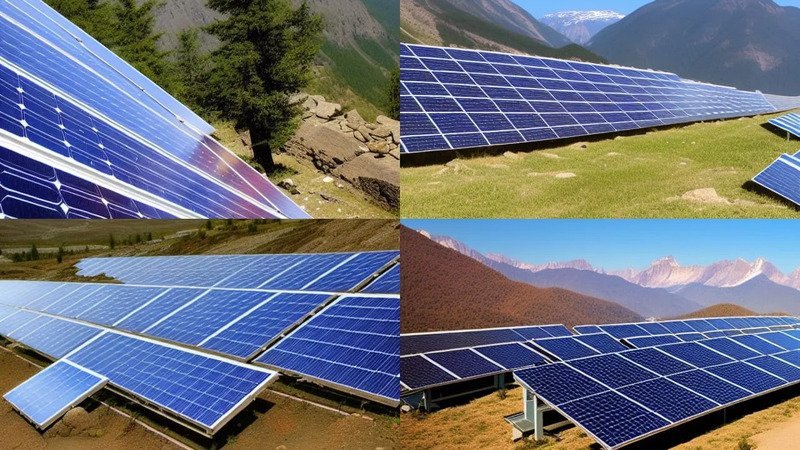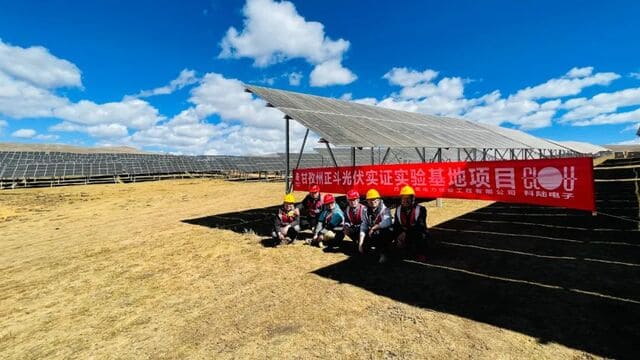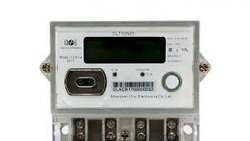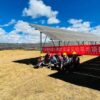Photovoltaic (PV) cells, commonly used in solar panels, are able to convert sunlight directly into electricity through a process called the photovoltaic effect. PV panels often get their power from low-lying areas where sunlight intensity is high, like deserts and industrial parks. However, technological advances have made it possible to use solar energy at higher altitudes and latitudes using higher-efficiency panels, also referred to as high-altitude photovoltaics.
CLOU is participating in a large scare research project in the Sichuan province, 3900 m to 4500 m above sea level. It is the highest photovoltaic demonstration base in China. It was put into operation on October 2022.
The Impact of High Elevation
There are several factors which need to be taken in consideration.

Environmental Temperature
The solar PV module's temperature directly affects how much electricity it can produce. The temperature coefficient, which measures production as a percentage for each degree Celsius (°C) rise in temperature above 25 °C, reflects this impact. The efficiency of solar PV modules is tested at 25 °C, which is the cell temperature of the Standard Test Conditions (STC). There will be a power loss of about 0.5% for each degree Celsius above 25 °C.
Heat is generated in the air by molecules colliding and creating friction.
With increasing altitude, the air pressure gets lower, there is less friction and the temperature drops. A common average value is a decrease of 6.5 °C per 1000 m. It can go up to 10 °C with dry air and anticyclone condition.
Solar Radiation
The phrase "solar radiation" is used to refer to the electromagnetic radiation that the sun emits. Geographical location, season, time of day, local landscape, and weather all have an impact on how much solar radiation reaches a specific area on the Earth's surface. With rising height, solar UV radiation increases while the amount of air molecules, ozone, particles, and clouds above the surface decreases.
Previous research has shown that solar energy harvesting at high altitudes is more effective than at sea level. There is less dispersed radiation and more direct radiation.
An installation in the Swiss Alps (elevation 1800 m) has shown a 50 % increase in efficiency. Our research project is elevated about 2 km higher.
Construction Challenges
The project met during the construction phase several challenges.
- Infrastructure
Roads had to be constructed to carry the equipment on this high elevation, as well as transmission lines for grid connection. - Workmanship on site
When a person's body is more than 2,100 m above sea level, the oxygen haemoglobin saturation starts to rapidly decline. Working in these altitudes can lead to medical problems, from the mild symptoms of acute mountain sickness to the potentially fatal high-altitude pulmonary edema.
The heart also beats more quickly, and the stroke volume is slightly reduced. A full acclimation to work in this altitude may take weeks. - Preserving the Environment
The grassland in this region is sensitive, especially to lack of water. All panels are mounted about 2 m above surface to keep the environment intact. At the same time, air ventilation will cool down the panels, which are getting hotter by generating more power than on lower ground.

Takeaway
PV panels at a higher altitude are receiving more solar radiation compared to the sea level, resulting in more generation of electricity.
CLOU is very proud to be part of the research base. In the next year cycle, we'll gain valuable information about the efficiency and reliability of our products under harsh environmental conditions.
Thank you for reading. We are following up.
Editor's note: This article was originally published in October 2022 and has been updated for comprehensiveness.





Thank you for your answer. We will be very smart about performance of this installations. Regards. Mariano
Congratulations for so good project done plus storage. In Chile we have some important mining and industry over 3.000 Mts sea level and some of the at 4.500 Mts sea level, one of them is 200-300 MW and was the first one to install solar panel in the past. Same with neighbors countries are over 5.500 Mts sea level where I worked for them some time ago, etc. If you interest we can offer this solutions. Please inform. Regards.
Thank you for your comment and additional information. It's for us still a research project, so it's too early to promote complete system solutions for high altitude photovoltaic at this stage. In our newsletter, we'll update our findings and results periodically.